State of Oregon v. Duehren #C96-054ICR
In 1996, Derrick Duehren was charged with Murder I and Arson I in the death of his first wife, Roxanne Duehren, and convicted by jury trial of Manslaughter I and Arson I based on the circumstantial evidence listed below.
Manslaughter I is a Measure 11 crime with a mandatory 10-year prison term with no opportunity for early release. Mr. Duehren served ten years in prison, maintained a spotless record of good conduct, and was released on Nov 30, 2006. He completed three additional years of required post-prison supervision with no reported incidents. Mr. Duehren has been employed since his release.
Mr. Duehren remarried in October, 2010. His new wife, Jeannine, is a head-strong retired radio personality and radio station owner who describes Mr. Duehren as the most gentle, thoughtful, and loving man she has ever known. They now live on 11 rural acres where they rescue horses (including BLM wild horses), dogs, cats, and a Macaw. In 2013, Mr. Duehren earned an MBA from the University of Portland. Now semi-retired, Derrick works part-time with Jeannine managing their real estate holdings.
Derrick & Jeannine at their wedding in 2010
Derrick & Jeannine in their backyard in 2014 (more photos at Duehren.com)
Derrick & Jeannine in Hawaii 2019. We travel 4 or 5 times a year as we both love it.
SUMMARY OF TRIAL EVIDENCE AND ARGUEMENTS
These are ALL of the issues presented to the jury. If you heard other claims about Roxanne's death, such as on Forensic Files, Season 11, Ep 39 "Fired Up", they were investigated and found not credible, or tested and failed. Hence the prosecution did not bring them up.
ISSUE 1: SCRATCHES ON FACE
State: Mr. Duehren has three parallel scratches, apparently from fingernails, on his face. These scratches are evidence of a violent confrontation with Mrs. Duehren and her fighting back by scratching.
Defense: Mr. Worley testified that Mr. Duehren told him that besides being scratched by a branch, Mrs. Duehren accidentally raked Mr. Duehren's face when they broke up a violent fight between their large Rottweiler dogs that morning. This explanation was supported by the testimony of four other witnesses who had witnessed violent fights between these two dogs.
The State also failed to explain, if there had been a fight, how Mr. Duehren had no other fingernail scratches on his body (face, neck, hands, arms).
ISSUE 2: BLOOD STAIN
State: Mr. Duehren had a small, 1½” diameter "transfer" stain of Mrs. Duehren's blood on his pants, evidence of a bloody fight with Mrs. Duehren.
Defense: The blood stain does not support a bloody fight theory for the following reasons:
1. The State could not explain how a stain of that nature (transferred or wiped, not dripped or splattered), of that shape/pattern, or in that unusual location (back of lower pant leg), could possibly come about as a result of a bloody, person-to-person fight.
2. Although Mr. Duehren stripped and was examined that evening and the State crime lab conducted meticulous tests on his clothing, there was not another speck of blood anywhere else on Mr. Duehren or his clothing. There also was no swelling or marks on his hands or knuckles to indicate a fight.
3. Photos showed that Mr. and Mrs. Duehren had similar waistlines and similar overall size. (She was physically able to wear his pants.) State crime lab DNA evidence showed that both Mr. and Mrs. Duehren had worn the pants since they were last washed. How long since these soiled and stained pants had been washed was not known.
4. The age of the blood stain was not known. There was no evidence of the blood being fresh.
5. This evidence is consistent with the defense theory that while wearing these pants and riding her horse, Mrs. Duehren could have wiped bloody fingers from a cut finger or bloody nose on the pants leg.
ISSUE 3: LIES
State: Mr. Duehren lied to police officers about the scratches on his face, claiming they came from injuries received while cleaning ice-laden branches from the side of the Duehren's long, rural driveway. He even went so far as to show Officer Park an exact spot where he had allegedly cleared branches.
Defense: Mrs. Reigle, a tragic-situation human psychology expert, provided rationale for Mr. Duehren to be unintentionally less than fully truthful about the scratches that tragic and confusing evening. Testimony supports the explanation that Mr. Duehren was scratched by Mrs. Duehren while breaking up a dog fight and later by the branches, which placed a small, fourth, diagonal scratch under his right eye.
ISSUE 4: DEMEANOR
State: Mr. Duehren's demeanor at the fire scene, as reported by several fire fighters, was unusual and suspicious, suggesting guilt.
Defense: No reliable conclusions can be drawn from Mr. Duehren's behavior. The testimony of the on-scene firefighters was inconsistent and contradictory. Some said his behavior was normal, some said it wasn't. Mrs. Reigle testified to the normalcy of Mr. Duehren's demeanor at this traumatic scene and during the later interrogation at the Sheriffs office.
ISSUE 5: AUTOPSY RESULTS
State: Dr. Larry Luman, State Medical Examiner, opined that Mrs. Duehren died by some “undetermined homicidal violence" because:
1. He found there was no soot in Mrs. Duehren's airway.
2. Initial tests of dried "body fluids" indicated approximately 3% CO (Carbon Monoxide), a non-fatal level. Later tests on a liquid blood sample indicated 37% CO (a potentially fatal level). These later tests were disregarded by Dr. Luman.
3. He allegedly found a "large amount" of blood in the bit of remaining distal trachea (the point where the lungs join at the top), indicating (but not proving) to Dr. Luman that Mrs. Duehren had "aspirated blood" from a severe, non-lethal, facial injury (breathed and choked-on blood from a severe beating).
Defense: Dr. Warner Spitz, a world renowned expert on fire death, lecturer, and author of widely used pathology textbooks, opined that Mrs. Duehren died either from smoke inhalation or a combination of smoke inhalation and a sudden blast of hot air and flame.
1. Dr. Spitz explained that it is common for people to hold a damp cloth over their mouth and nose in a fire. This cloth effectively blocks soot, but not the deadly CO gases, from reaching the lungs. This explains the lack of soot in Mrs. Duehren's airway.
2. Dr. Spitz explained that the variances in the blood and body fluid test results are easily explained by the poor condition of the various fluid samples. The sample that contained 37% CO, the only sample of true blood, was simply the highest quality, least damaged sample.
Dr. Spitz testified that, other than a Petri dish of blood exposed to CO-saturated air absorbing 1 % or 2 % CO, the only way for CO to have been absorbed into the blood sample from Mrs. Duehren was for her to have been breathing CO-saturated air, such as in a burning house. This blood sample was tested twice, both times registering 37% CO. Regardless of this blood sample's inconsistency with the results from the "body fluids" tested earlier, this test result proves beyond any doubt that Mrs. Duehren was alive and breathing in the fire.
3. Dr. Spitz explained that it is common for blood to be squeezed out of the lungs and into the distal trachea as a normal function of the lungs contracting as they heat up in a fire, thereby explaining the blood Dr. Luman found.
Note that the blood from the distal trachea was not photographed, nor preserved in any way, nor any tests done on it. This failure to preserve key evidence denied the defendant any opportunity to confirm the existence of this alleged evidence, nor any opportunity for independent analysis.
The homicidal violence theory is unsubstantiated. The autopsy and toxicology results disprove it. The complete lack of corresponding damage to Mr. Duehren's hands, arms, knuckles, nor damage to his face other than a single swipe of fingernails, further disproves this theory, as does the complete lack of any blood splatter on Mr. Duehren's clothing, other than the oddly located stain on the lower back pants leg (see Issue #2).
ISSUE 6: STRANGULATION THEORY
State: Regardless of the lack of evidence of any specific cause of death, Mr. Bletko, during his rebuttal closing argument, suggested that Mr. Duehren strangled Mrs. Duehren, including a sensational hands-grabbing-his-throat demonstration in front of the jury.
Defense: There was no evidence of strangulation and the jury was instructed to disregard this suggestion. Did they?
1. The autopsy showed that although the front of the neck was completely burned away, there was no damage or bruising of the surviving muscles in the back of the neck. This evidence mostly precludes strangulation.
2. No evidence of any specific cause of death was presented to the jury. No "damage" was found to any part of Mrs. Duehren's remains, including the skull and all of the major organs of the body.
Unfortunately, the defense had no opportunity to argue against this inappropriate suggestion, which was made by Mr. Bletko during the very last comments to the jury before deliberation.
ISSUE 7: FIRE THEORIES

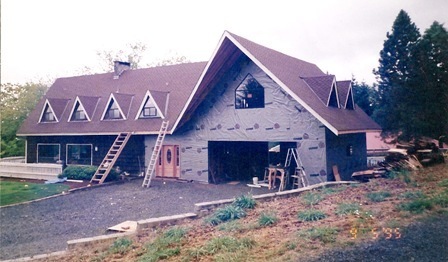
State: Detective Whitaker, the State's fire expert, opined that the Duehren residence fire was intentionally set by Mr. Duehren disconnecting the propane gas supply hose to the clothes dryer and igniting the gas, creating a large flame. Mr. Whitaker based this conclusion on the following interpretation of the evidence:
1. The utility room showed the greatest amount of fire damage.
2. Investigation of the propane gas line showed a melted brass coating on the steel nipple at the back of the dryer and no similar brass coating on the steel nipple of the brass turn-off valve of the propane supply pipe. Mr. Wong, the State metals expert, concluded that the lack of a brass coating on the valve nipple indicated that the propane hose's nut had been disconnected before the fire destroyed the house.
Mr. Wong also opined that the small brass balls within the threads of the flex-hose fitting resulted from splattered liquid brass drops somehow solidifying in air hot enough to melt brass and then landing and sticking to the exposed pipe threads. He conceded that the only source of brass in that area of the house was the nut that Mr. Duehren is suspected of removing from the gas line at the wall.
3. Fire damage to the Suzuki Sidekick parked in the garage could be attributed to gasoline leaking from the gas line below the car's engine. Furthermore, Det. Whitaker testified that the garage door was wedged under a rear wheel of the Suzuki, indicating that the door had collapsed before the tires blew out. (The fire scene photos depict the garage door nearly three feet away from the Suzuki in the fire debris, not under the car as Det. Whitaker testified.)
Defense: Mr. Janes, the defense's fire expert, opined that the Duehren residence fire was an accidental fire, most probably begun by an electrical anomaly in the engine compartment of the Suzuki Sidekick while parked in the garage and could not have possibly begun in the utility room.
In addition to the clear and untainted evidence supporting this theory, enumerated below, the defense exposed the lack of competence and the questionable integrity of the State arson and metals experts who:
• Failed to preserve significant exculpatory evidence from the suspected fire source area (large pieces of unburned wood).
• Failed to preserve a critical ball of brass found in the treads of the valve nipple (Photo 1).
• Sprayed brass dust over the valve nipple, making it virtually impossible to search for other, fire caused, microscopic brass fragments. The need for this additional search was increased by the loss of the brass ball.
• Failed to admit even blatantly obvious problems with their theory.
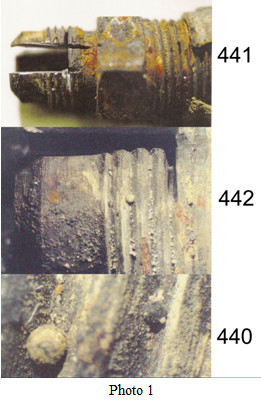
Mr. Janes, and Dr. Held, the defense metals expert, based their conclusions on the following interpretation of the evidence:
1. The fire started in the south end of the garage (see figure 2).
2. Various burn patterns in and on the Suzuki are consistent with an electrical anomaly igniting the car's engine compartment, the car, and then the south side of the garage. (Photo 2)
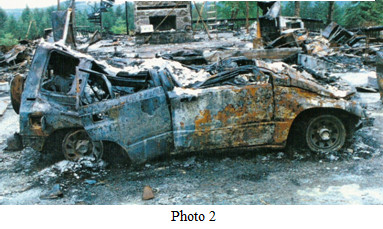

3. The south end of the garage door header beam suffered significantly more damage than the north end.
4. The gutter from the eave over the south side of the garage was deposited, during the fire, on top of a six foot tall retaining wall, 8½ feet south of the house foundation.
5. The cave-in pattern on the roof of the Suzuki is consistent with the top ridge beam of the roof landing at an angle, parallel to the south garage gutter.
This evidence, and the testimony of the first firefighters on the scene proves, beyond any doubt, that the south garage wall fell outward, south, and therefore first. This wall did not fall into the garage, as opined by Det. Whitaker. 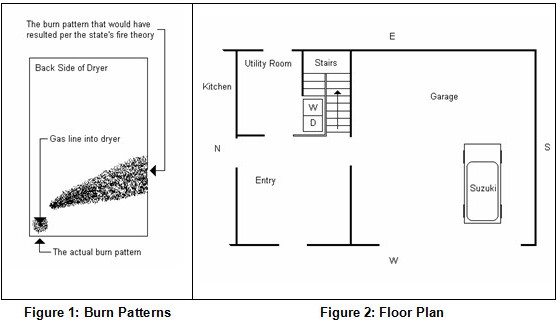
2. The fire could not have possibly originated in the utility room.
a. The wood floor post and beam behind and under the clothes dryer are the least damaged post and beam segments in the house. The post is in remarkably good condition, the top is not even charred by the fire (Photo 3).

b. The sill plate at the base of the wall between the garage and utility room, the wall closest to Det. Whitaker’s alleged fire origin, is the least damaged sill plate in the entire house.
3. The propane gas hose behind the clothes dryer was connected and failed late in the fire process.
a. The prosecution and defense experts agree that the brass nut on the end of the flex hose connected to the dryer nipple was properly connected and subsequently melted in the fire. Therefore, the brass nut fragments found at the scene came from the other end of the flex hose, at the valve nipple.
The nut could have fractured only if it was connected during the fire. If the nut had been disconnected before the fire, and was merely lying in the fire, it would not have the stress required to fracture it into pieces (photo 4).
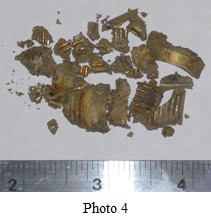
b. Dr. Held’s experiments demonstrated that the small balls of brass found in the valve nipple threads came from a brass nut that fractured and fell off as it’s temperature approached the melting temperature of brass.
c. The fire debris behind the clothes dryer was carefully examined and documented by the State fire investigators as follows:
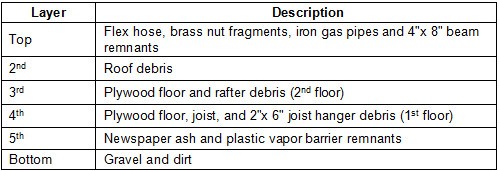
This layering clearly shows that the entire house, including the roof, collapsed and fell past the sturdy 4” x 8" first-floor beams. These beams took a considerably long time to burn through. These beams supported the iron propane gas pipe, the propane brass valve, and one end of the flex hose (the other end had been pulled down into the crawl space, connected to the dryer).
The copper flex hose and the brass nut finally fractured from the stress of being tightly torqued and the immense heat of the burning embers of the house and roof that had fallen below the flex hose and valve. The flex hose and brass nut pieces fell onto the roof debris, at the top layer of the fire debris, late in the fire.
d. The burn pattern on the back of the cloths dryer is consistent with a gas line fracture where the flex hose connects to the clothes dryer nipple. Possibly a crack formed when the dryer fell through the floor into the crawl space.
This burn pattern directly contradicts Det. Whitaker's theory. His theory proposes a large propane flame shooting from the valve nipple which would begin at least 6 inches off of the floor and shoot horizontally between the clothes dryer and the stud wall. This flame would have created a horizontal burn pattern of the back of the dryer (and washer). Instead, the actual burn pattern on the clothes dryer is a relatively small circle around the propane inlet in the lower corner of the dryer. (see Figure 1 and photo 5)

ISSUE 8: TIME LINE AND ALIBI
State: The timeline gave Mr. Duehren enough time to commit the crimes and then shop for groceries.
1. Desi Holt, a friend of Mrs. Duehren, testified that Mrs. Duehren spoke cheerfully to her by phone between noon and 1 :00 PM.
2. The fire started around 2:00 PM.
3. Mr. Duehren checked out of the Forest Grove Safeway Store at 2:46 PM and the Ace Hardware Store at 3:02 PM. (The drive into town took at least 20 minutes.)
4. Mr. Duehren told the police investigators that he had left the house sometime after 1:00 PM.
Defense: The timeline not only supports Mr. Duehren's innocence but also makes it nearly impossible for him to have committed the crimes.
1. Bill Duehren, the defendant's father, testified that Mr. Duehren was the cook in the family. It is not uncommon for a person to spend an hour shopping in a large grocery store, especially one who cooks.
2. The State's theory would make Mr. Duehren into both an incredibly bright and stupid person who could, all within the span of about an hour, get into an argument with his wife sufficient to incite him to kill her in a fit of anger, and then have the presence of mind and skill to do all of the following:
a. Decide to cover up the death instead of reporting it.
b. Decide to burn down their beautiful home and all of their possessions. Several witnesses testified to Mr. Duehren designing and building half of this house with his own hands. He would have been intentionally destroying all of his hard work when there would have presumably many other ways to dispose of the victim’s body.
c. Figure out and decide on a highly unusual and stupid means to light the fire – using inflammable pipe fittings to start the fire and do so nowhere near the victim’s body.
d. Create a very complicated story of broken frozen water pipes to have a an excuse to run an errand in town. A story that would stupidly involve using the dryer exhaust hose to thaw the pipes – unnecessarily drawing the investigators’ attention to the ignition source (the gas line to the dryer).
e. Figure out and set up an extra “diversion” by putting a halter on a horse, letting it out of it’s stall, and scattering horse grooming supplies on the ground outside the barn’s tack room.
f. Figure out and stet up a story of clearing branches and stomping in the snow to make fresh tracks to later show the police.
All of this cleverly conceived and carried out within in an hour when there was no reason to hurry. The Duehren's lived in a secluded location with no neighbors. Mrs. Duehren was not due back at work for three days.
ISSUE 9: HORSE AND GROOMING EQUIPMENT
State: Even though he had very little time, Mr. Duehren could have "planted" the horse equipment to make it look like Mrs. Duehren ran off in a hurry.
Defense: The condition of the horses and the horse grooming equipment and other related evidence support the defense theory that Mrs. Duehren was at the barn, grooming a horse, when she noticed the fire, screamed, ran into the non-burning north end of the house, and died while searching for her cats on the second floor. Several witnesses testified to her love of animals and over-protective nature.
ISSUE 10: WOMAN'S SCREAM HEARD
State: Officer Park testified that he talked to a neighbor, Mrs. Clapshaw, the night of the fire, by cell phone. Officer Park testified that Mrs. Clapshaw told him that she wasn't sure the sound she heard was a woman's scream.
Defense: Both Mrs. Clapshaw and her son testified to hearing one long woman's scream coming from the direction of the Duehren's home, and at the same time, saw smoke and flames.
Mrs. Clapshaw testified that the scream sounded like how she would scream if she saw her house on fire.
This testimony supports the defense theory that Mrs. Duehren was alive after 2:00 PM and screamed before running into the house to rescue her cats.
ISSUE II: LOCATION OF THE REMAINS
State: The State presented no evidence nor theory to explain the location of Mrs. Duehren's remains and how the location could possibly fit in their homicide theory.
Defense: The location of Mrs. Duehren's remains is consistent with the defense theory that Mrs. Duehren died when she opened the door between the two upstairs bedrooms or simply collapsed in the hallway between the bedrooms from smoke inhalation. The location of the remains is inconsistent with a homicide/arson theory. The fire began far from the remains instead of at the site of the remains, which would be expected if a killer is trying to destroy a corpse.
ISSUE 12: LACK OF MOTIVE
State: The State provided NO motive testimony or evidence nor any reason for these alleged crimes.
Defense: There was no evidence showing any motive for Mr. Duehren to plot and kill his wife. Nor was there any history or pattern of violence to suggest that Mr. Duehren was capable of, or at all likely to suddenly and violently kill his beloved and beautiful wife. The State presented absolutely no one to say there was any problems or violence in the Duehren marriage. To the contrary, 16 witnesses, including the last people to see them together, testified to the health and vitality of the marriage.
ISSUE 13: MR. DUEHREN'S CHARACTER
State: The State produced no evidence to show any negative side to Mr. and Mrs. Duehren's relationship, nor to Mr. Duehren's character in general.
Defense: Testimony was given regarding Mr. Duehren's many outward signs of love and support of Mrs. Duehren (physical signs of affection, as well as attending horse shows, clearing pastures, and building barn facilities and a massive riding arena). Testimony was also given regarding Mr. Duehren's civil involvement with youth (years as Scoutmaster of a Boy Scout Troop, executive committee member of the Oregon Congressional Award Council). One can infer from this testimony that Mr. Duehren is patient, loving, generous, forgiving, civic minded, and peaceful.

Derrick and Roxanne in 1992

